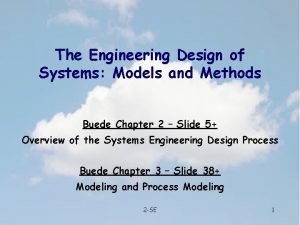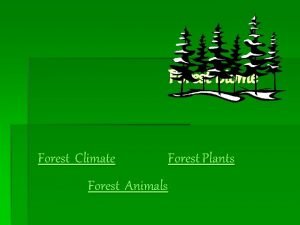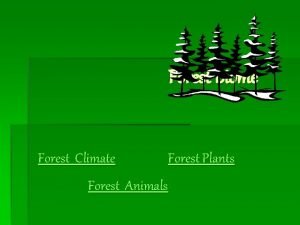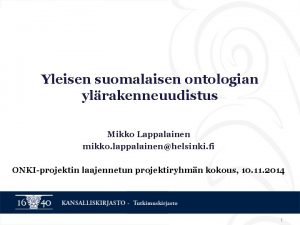Forest growth models and new methods Mikko Peltoniemi










- Slides: 10

Forest growth models and new methods Mikko Peltoniemi, Luke © Luonnonvarakeskus

Interests towards forest models • A wide range of interests towards quantified forest dynamics exist • Economical interests, often timber supply • Biodiversity • Carbon storage, from local to global levels • Nutrient leaching • Vulnerability and resilience • Etc … 2 Mikko Peltoniemi 25. 9. 2020 © Luonnonvarakeskus

Model complexity range, and some benefits • One leaf - Mean tree models – for homogenous canopies (e. g. CROBAS) • Cohort models (trees of different size in homogenous cohorts) – Allows including size-dependent competition, and differential development of different sized trees (e. g. MOTTI, Pipe. Qual) – Often cohort NPP divided up into trees, which allocate it using some scheme • Gap-models: homogenous cohorts organised in space (4 C, JABOWA) – Allows modeling some heterogenity of species and disturbances, gap formation, and regeneration 3 Mikko Peltoniemi 25. 9. 2020 © Luonnonvarakeskus

Model complexity range, and some benefits, cont. • Spatially explicit forest models (e. g. Sortie, Maespa) – Individual trees with location: allows explicit competition / mortality /regeneration description – Dispersal, … – light (bioclimatic) environment simulation – Canopy may be very simplistic • FSPM: + Detailed within tree and structure and http: //maespa. github. io/ physiology. • Other differiating features in models – Process comprehence and detail – Temporal resolution – Mikko Approach, process-based 25. 9. 2020 / empirical 4 Peltoniemi © Luonnonvarakeskus

Model complexity range, and some benefits, cont. • Increasing detail of complexity allows simulating new things and wider facilitation of other research fields • In many occasion simple and effective descriptions of environment and dynamics are still desirable – Speed of calculations (e. g. global models) – Maintance of system • Increasing detail does not necessarily mean better statistical performance of models, and often contrary has been found © Luonnonvarakeskus

Schematic example of model complexity gains • Daily stand photosynthesis vs. eddy covariance GPP Model complexity vs. uncertainty Uncertainty of GPP But what was the innovation here? ”Big-leaf” 6 Mikko Peltoniemi Two-leaf Multilayer 25. 9. 2020 Individual multilayer canopies © Luonnonvarakeskus

So why would we not get continuously decreasing trends? • Possible partial explanations – Data quality – Long testing / calibration tradition with simpler models – Limited knowledge on processes and feedbacks ”Big-leaf” 7 Two-leaf Mikko Peltoniemi Multilayer Individual multilayer canopies 25. 9. 2020 © Luonnonvarakeskus

New methods for identifying innovations? • The largest gains in previous examples were obtained when shade and sun leaf were separated • Can we inform simple models based on experiences with complex models? – What other innovations exist? 8 Mikko Peltoniemi 25. 9. 2020 © Luonnonvarakeskus

A look at literature: some old innovations and hypotheses used or could be used (in simpler) models • • • 9 Functional balance (Davidson 1969) – The roots’ nitrogen uptake and shoots’ C uptake should be in balance Scaling relationships, e. g. pipe model (Shinozaki et al. 1964) and derivatives Mechanics of branch structure (Mc. Mahon 1973) Steming from evolution theory – Plants should maximize their fitness (or fitness proxy) – Several studies exist where resources are spent optimally to sustain a function. – Optimal vertical N allocation (Sands et al. , 1995, Badeck et al. , 1995) + hydr. conductance (Peltoniemi et al 2012) – Allocation of C+N to maximize growth/NPP (Mäkelä et al. ) Community level responses: – self-thinning rules (Reineke, Yoda) – Distance to neighbours… Etc… Mikko Peltoniemi 25. 9. 2020 © Luonnonvarakeskus

Discussion topics? • How to transfer knowledge from complex ecosystems to models that serve practical scenario purposes? • Or how to generate useful tools from FSPM/lidar context? • Levels of required complexity of individual processes? • What are priority improvements needed? • How to use new methods in this • Identify new and verify old theories / innovations / hypothesis / emergent rules? …that operate at higher level – What kind of innovations / hypothesis / emergent rules are the most prospectful? 10 Mikko Peltoniemi 25. 9. 2020 © Luonnonvarakeskus
 Paistinlasta englanniksi
Paistinlasta englanniksi What is the difference between model and semi modal
What is the difference between model and semi modal Business analytics methods models and decisions
Business analytics methods models and decisions Decision tree business analytics
Decision tree business analytics Business analytics methods models and decisions
Business analytics methods models and decisions Four special cases in linear programming
Four special cases in linear programming The engineering design of systems: models and methods
The engineering design of systems: models and methods Growth analysis
Growth analysis Eudicot
Eudicot Primary growth and secondary growth in plants
Primary growth and secondary growth in plants Primary growth and secondary growth in plants
Primary growth and secondary growth in plants



















